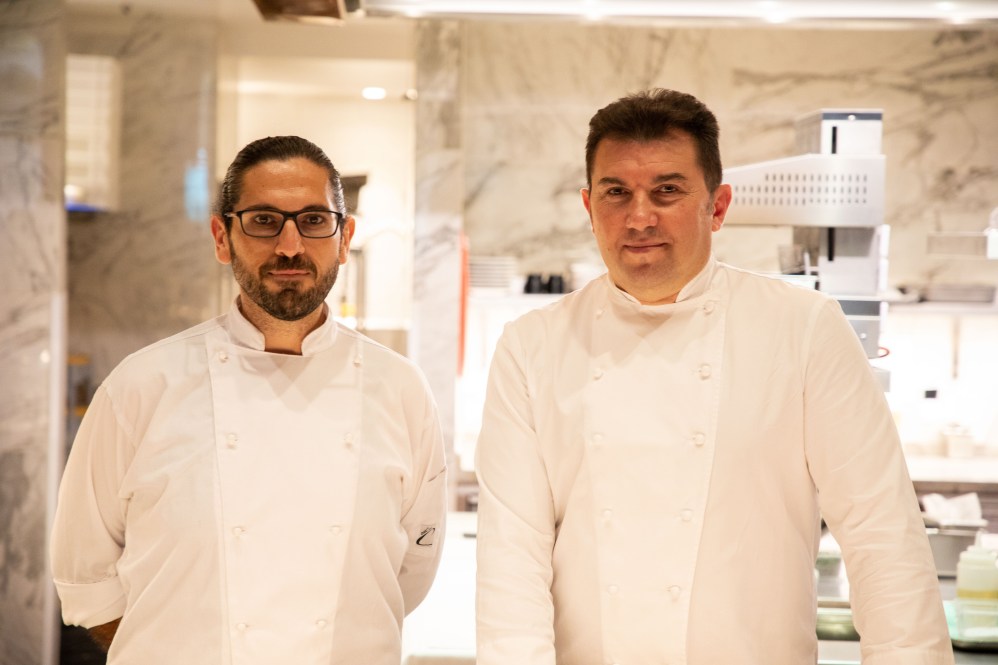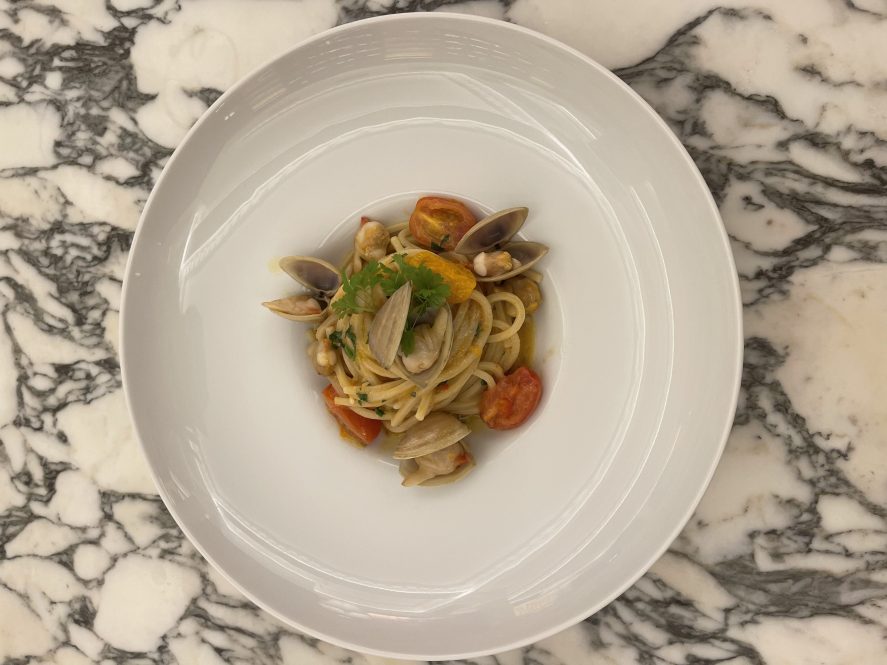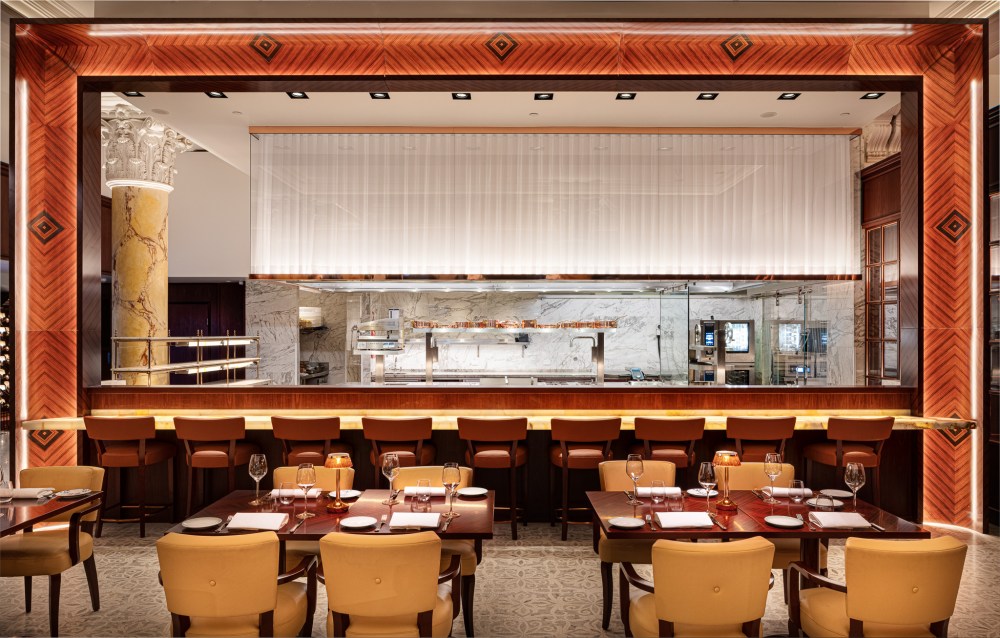The vernacular of Italian cuisine is rooted in simplicity. And there’s arguably no better example than spaghetti alle vongole; a dish comprising just a handful of ingredients. But it’s one that’s transportive, conjuring memories of seaside trips or perhaps thoughts about the origins of the star ingredient — clams.
Translating to spaghetti with clams, there’s not much else to spaghetti alle vongole, which means it’s one of those dishes that requires patience and a high level of skill to get right. From soaking the clams in water to draw out sand to steaming them before the point of chewiness, there’s a lot of ground to cover.
Hospitality speaks to Head Chef Davide Incardona from Seta Sydney about the nuances between clams in Italy and those used in Australia, the pressure points of the cooking process and why chefs should always keep pasta water on the side.
The man behind spaghetti alle vongole’s rapid ascent to staple pasta is none other than Italian stage actor Eduardo de Filippo. The actor made the dish post-show using the few ingredients he had in his kitchen: spaghetti, tomatoes, garlic, parsley and chilli.
As you’ll notice, there are no clams on the list. The next day, De Filippo told his sister he made spaghetti alle vongole fujute (escaped clams). The story would go on to be published in a cookbook authored by his wife, who said he was adamant the parsley provided a taste of the sea.
Italian-born Davide Incardona has made countless plates of the dish which is “typical in Napoli” over his 20-year career. Incardona took on the head chef role at Seta in Sydney’s CBD in December last year after time at Bel & Brio and stints across Europe working in lauded kitchens.

While spaghetti alle vongole isn’t on the core menu at Seta, it runs as a special and is a guaranteed boon for the kitchen. “It’s a very popular dish,” says Incardona. “Many chefs like myself think it’s so common and is something you don’t really want to recreate again. Some people might not want to cook it because it’s very easy to make the clams chewy if you don’t use the right technique and do it the proper way. But customers really like it.”
Neapolitan cuisine has always heavily drawn on seafood, with clams used in various dishes for more than 400 years. The Mediterranean is home to several species of clams, but vongole verace is prized in a pasta application.
“Vongole verace are the most common and are found everywhere in the Mediterranean,” says Incardona. “They’re more salty and less chewy than other types of clams and can be used in fish soup, lasagna and many different dishes.”
The distinct flavour profile of spaghetti alle vongole comes down to the clams, which offer a taste of provenance. While clams accessed in Australia are comparable to those in Italy when it comes to appearance, the eating experience is naturally very different. “The microclimate in the Mediterranean makes clams much richer in salt and flavour,” says Incardona. “But Diamond Shell clams are similar to verace vongole in size.”
Seta sources Diamond Shell clams from New Zealand, which have a beige-coloured shell and a “mild, sweet ocean flavour … characterised by its sweet, fresh sea spray aroma”.

Most producers soak clams after harvesting to allow them to expel sand or sediment, but chefs should undertake the process themselves to be safe. Incardona leaves the clams in salted water for three to four hours to ensure nothing grainy makes it to the plate before washing them again. “It’s one of the most important steps,” says the chef. “You need to take your time to make sure all the sand is gone.”
There are several regional variations of the ‘sauce’ component of spaghetti alle vongole. Bianco is the classic, with the addition of tomatoes and basil seen in the south of Italy and Sardinia going heavy on the chilli. In Liguria, baby clams no bigger than a fingernail are used. And over in America, some even add cheese, much to the dismay of purists. “Definitely no cheese,” says Incardona.
Seta sticks with the foundational recipe, which begins with heating olive oil in a pan over a high heat before garlic and white wine is added. “You just need to use cooking wine as it evaporates and doesn’t leave much flavour in the dish,” says Incardona. “It’s used to generate steam and quickly open the clams because you don’t want to overcook them — it’s the main reason for the wine.”
A pot of salted boiling water should also be on the go by now, especially when the cooking time for the pasta is factored in. Incardona uses dry pasta from an Italian brand called Verrigni.
“We get it from one supplier because you can’t find it anywhere in Australia,” he says. “We choose it because they respect tradition in the production process and the amount of gluten in the pasta is perfect for creating sauces, especially for a dish like vongole. If you don’t add cherry tomatoes or any other ingredients that help make a sauce, you need the gluten to emulsify with the water.”

Like the dish says, spaghetti is the pasta of choice. Incardona recommends no.3 or no.4, but other options can be used. “Any kind of long pasta is fine as long as it’s not too thick,” says the chef. “You can use tagliolini. Thin pasta is better; thick pasta is too hard to mix.”
Once the vongole are added and the wine has evaporated, Incardona covers the pan to expel the water from the clams, which forms part of the sauce. “I move the pan, so the steam opens up the vongole, which are ready as soon as they open,” says the chef. “If you go one minute over, the clams become chewy.”
The rest of the dish comes together in a flash after this point despite it being around
a 25-minute task in total. The cooked pasta is added to the pan along with cherry tomatoes, which only need to be lightly cooked. “You want to cook the spaghetti with the vongole for about six minutes to create a thicker sauce where the gluten and the water come together,” says Incardona.
“The tomatoes also give some colour to the sauce and then you add parsley. We add black pepper or chilli for taste, but it’s always one or the other. I use fresh chilli, but you can also use chilli flakes.”
In a dish where every second counts, there’s no room to hide. But the overarching note of the eating experience is no doubt the salinity of the ocean from the clams, and arguably, the parsley if you take de Filippo’s word for it. “It has a mussel saltiness but a lighter flavour,” says Incardona. “The main thing you get from vongole is the sea.”
Much like cacio e pepe, pomodoro or arrabiata, spaghetti alle vongole is beloved in Italy and across the globe for its intelligibility. Each component of the dish is recognisable to the eye and the palate. Basically, you know exactly what you’re going
to get: acid and sweetness from the cherry tomatoes, richness from the olive oil, brininess from the clams, heat and pungency from the garlic and chilli and herbaceous bitterness from the fresh parsley.
Spaghetti alle vongole is emblematic of highlighting the best of the best and taking the time to nail each component of the dish. As aptly put by Incardona, “It’s a classic.”
Sponsored Content

Discover Dairy Farmers’ range of shredded cheese
Sponsored by Bega

Beachfront Melbourne Club catering & restaurant opportunity
Sponsored by Future Food
Trending Now
Resources
Lorem ipsum dolor sit amet, consectetur adipiscing elit. Fusce ac ornare lectus. Sed bibendum lobortis...
Lorem ipsum dolor sit amet, consectetur adipiscing elit. Fusce ac ornare lectus. Sed bibendum lobortis...
Sign up for our newsletter
